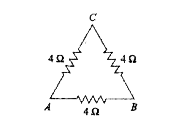A conductor of resistance 3Ω is stretched uniformly till its length is doubled. The wire is now bent in the form of an equilateral triangle. The effective resistance between the ends of any side ofthe triangle in ohms is:
92
83
2
1
The correct Answer is:B
The resistance of a conductor of length l, cross-sectional area A and made of a material ofresistivity p is given by:
R=ρlA=ρl2Al=(ρV)l2
where V=AI is the volume of the conductor. Since ρ is a constant and volume V cannot change if the conductor is stretched, it follows that R is proportional to l2. Thus if l is doubled, R becomes four times.
Hence the new resistance is 3×4=12Ω. So, each side of the equilateral triangle has a resistance of 4Ω as shown in Fig. Therefore, the effective resistance between the ends of any side of the triangle (such as side AB) is equal to the resistance of a parallel combination of R1=4Ω and R2=4+4=8Ω, which is given by

R=R1×R2R1+R2=4×84+12=83Ω
Similar Questions
A conductor of resistance 3Ω is stretched uniformly till its length if doubled. The wire is now bent in the form of an equivalent triangle. The effective resistance between the ends of any side of the triangle in ohm is
View SolutionA conductor of resistance 3 ohm is stretched uniformly till its length is doubled. The wire now is bent in the form of an equilateral Delta. The effective resistance between the ends of any side of the Delta in ohms is
View SolutionA wire has a resistance of 12 ohm . It is bent in the form of equilateral triangle. The effective resistance between any two corners of the triangle is
View SolutionA wire has a resistance of 12 ohm . It is bent in the form of equilateral triangle. The effective resistance between any two corners of the triangle is
View SolutionThree resistance of 12Ω are connected in the form of an equilateral triangle. The effective resistance between two corners, is
View SolutionA uniform wire of resistance 2R is bent in the form of a circle. The effective resistance between the ends of any diameter of the circle is
View SolutionA wire has resistance 12 ohms. If it is bent in the form of a equilateral triangle. The resistance between any two terminals in ohms is:
View SolutionThree resistances 4Ω each of are connected in the form of an equilateral triangle. The effective resistance between two corners is
View SolutionThe resistance of a wire is R. It is stretched uniformly so that its length is doubled. The resistance now becomes
View SolutionA Wire of resistance 12 ohm is bent in the form of a circular ring. The effective resistance between the two points on any diameter of the circle is :
View Solution

